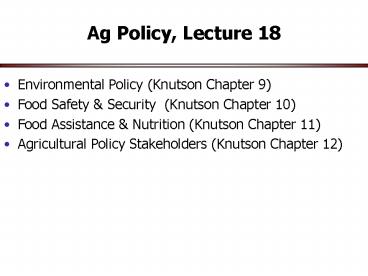Ag Policy, Lecture 18 - PowerPoint PPT Presentation
1 / 21
Title:
Ag Policy, Lecture 18
Description:
Some have recommended a single food agency (would agriculture support this idea? ... India, China, Southeast Asia and much of Africa. Even affluent countries ... – PowerPoint PPT presentation
Number of Views:26
Avg rating:3.0/5.0
Title: Ag Policy, Lecture 18
1
Ag Policy, Lecture 18
- Environmental Policy (Knutson Chapter 9)
- Food Safety Security (Knutson Chapter 10)
- Food Assistance Nutrition (Knutson Chapter 11)
- Agricultural Policy Stakeholders (Knutson Chapter
12)
2
Environmental Policy
- What economic principle creates the policy
motivation concerning environmental regulation?
3
Environmental PolicyGovernment Contributors
- Development and Implementation
- Congress
- Policy Development
- Environmental Protection Agency (1972)
- Implementation
- Writes Regulations Rules
- State EPAs
- Enforcement
- Handles Permits
- Cities
- Zoning
- Courts also play a role in dispute settlement
4
Environmental Policy Concepts
- Pollution
- Point Source vs. Non-Point Source
- Willingness to Pay for a Environment
5
Environmental Policy Issues
- Water Quality
- Air Quality
- Global Warming
- Policy Options
- Common Law
- Proscribing vs. Prescribing
- Practices vs. Performance
- Cost Sharing (EQIP, CSP)
- Cross-Compliance
- Taxation
- Right-to-farm laws
6
Who is responsible for a food safety?
- Buyer beware
- Government
- Food Supply Chain
7
Who is responsible for a food safety?
- FDA
- Processed
- Food service
- USDA
- A number of other agencies participate
- Some have recommended a single food agency (would
agriculture support this idea?)
8
Protecting Food Safety
- Whos job is it?
- USDA inspects red meats, poultry, and processed
eggs (1/4 of food) domestic - 8,000 inspectors
- FDA inspects seafood, cooked, canned and baked
products, whole eggs, produce and animal feed
(3/4 of food) both domestic and imported. Also
inspects animal feed and its label. - 1,550 inspectors
9
Protecting Food Safety
- USDA meat inspectors
- Inspector on site during operating hours at
packing plants - 6,500 slaughter houses in the USA
- Monitor meat for signs of fecal matter and other
problems - USDA can not force plant closure
- But it can withhold USDA inspection stamp
- USDA can also remove inspectors
10
Hierarchy of Concerns
- Matters of Life Death
- Consumers Right to Know
11
Safety Concerns/Policy Standards
- Naturally occurring substances
- Buyer beware
- Education
- Labeling
- Health problems
- Education
- Labeling
- Self-regulation
- Chemical residues and additives
- Self-regulation
- No significant risk
- Negligible risk
- Reasonable certainty of no harm
- Biosafety/Food-borne pathogens
- Negligible risk
- Reasonable certainty of no harm
- Zero Tolerance
- Bio-Terrorism
12
Range of Options
- How far should the government (society) go in
assuring food safety - What is the trade-off?
13
Pesticides and Food Additive Safety
- Delaney Clause (1958 Food Additives Amendment)
- Zero tolerance
- Proved unworkable due to technology
- Food Quality Protection Act of 1996
- Reasonable certainty of no harm as the standard
for determining an acceptable level of risk
14
Animal ID and COOL
- National Animal Identification System
- Tracking Animals
- Controlling/Containing Disease Outbreaks
- Tracking ends at slaughter
- Country Of Origin Labeling
- Tracing food products through retail
- Most products will be exempt
15
Food Assistance and Nutrition Policy
- Most severe hunger problems
- India, China, Southeast Asia and much of Africa
- Even affluent countries have hunger problems
- Hunger Insufficient protein and calorie intake
to maintain normal growth, health, and body
function.
24
16
Factors Contributing to Hunger Problems
- Low Income
- Income Distribution
- Price of Food
- Lack of Education
- Poor Health
- War
24
17
Perspectives on Hunger Intervention
- Activist
- Every human has a right to food that those who
are not suffering have an obligation to supply
even if it means self sacrifice - Adapter
- World scarcity decisions must be made balancing
short and long-term needs - Acceptor
- Does not acknowledge there is a problem or need
for intervention - Any intervention will likely create bigger problem
18
Reducing World Hunger
- Food Self-Sufficiency
- Food Price Controls
- Food Aid (short term)
- Food Assistance (longer term, programmatic)
- Education
- Health Care
- Private Land Ownership
- Infrastructure development
- Research
19
U.S. Hunger Nutrition Policy
- U.S. total population 300 million
- U.S. Hunger
- 36 million labeled Food Insecure
- 9.6 million experienced hunger
20
U.S. Hunger Nutrition Policy Options
- Food Assistance
- Commodity Distribution
- Food Stamps
- Child Nutrition
- Women, Infants, and Children (WIC)
- Senior Nutrition
- Education
- Dietary Guidelines
- Labeling
21
Lecture 18, Wrap up
- Can you answer these?
- Who contributes to environmental policy, and what
is the role of each? - What is the difference between point source and
non-point source pollution? - How does income affect a countries attitudes
toward environmental policies? - Can you describe the primary environmental issues
and policy options? - Can you describe the primary food safety concerns
and policy standards? - Explain the trade-offs associated with achieving
extremely high levels of food safety. - Explain how tolerance levels and technology have
interacted over the years to change the way we
approach pesticide residue and other
contamination levels in food products. - What is the difference between the tracking of
Animal ID and the traceability concept involved
with COOL? - Can you discuss the factors that contribute to
the hunger problem? - Can you discuss the options to help reduce world
hunger? - What are the positives and negatives of Food Aid?
- Can you discuss the primary components of U.S.
Hunger Nutrition policy? - Can you analyze the position of the 5 key
stakeholder groups relative to various
agricultural and food policies?































